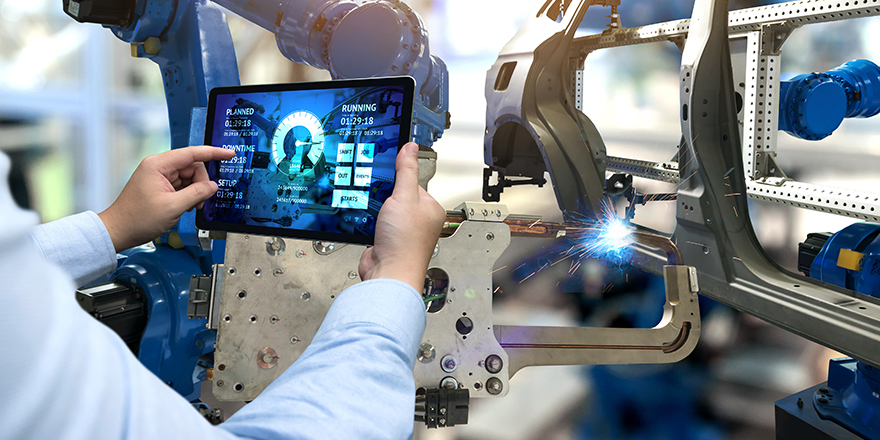OEE: If you measure it, success will come
OEE is the best metric for identifying losses, benchmarking progress & improving manufacturing equipment productivity. Read how Cumulocity IoT can help.

Small- to mid-sized manufacturers and smart machine makers need a way to better measure overall equipment effectiveness without the expense and effort of expensive manufacturing execution systems (MES).
According to Peter Drucker’s theory, measuring results is the only way to manage and improve your product.
But of all the measurements, stats, KPIs and data that you can collect, only a portion of it is useful. So, what do you need? In manufacturing, it is clear you must measure production line efficiency, uptime and quality of your products to improve them and beat competition.
The way that large manufacturers measure this is with overall equipment effectiveness (OEE), which shows how well – percentage-wise – a manufacturing operation is being utilized (facilities, time and material) compared to its full potential. A 100% OEE means that only good parts are produced (100% quality), at the maximum speed (100% performance), and without interruption (100% availability).
For this, larger manufacturers use heavy-duty MES to track and document the transformation of raw materials to finished goods. An MES system is like an SAP ERP for the shop floor. For smaller to mid-sized manufacturers and machine makers, these systems are simply too large and expensive, plus they require trained personnel to run them.
Eric Sander, Senior Manager Strategic Initiatives at Software AG, said: “Smart machine makers, like the ones in the ADAMOS ecosystem, are under increasing pressure to IoT-enable and add value to their products, especially with the widespread industry trend toward selling products as a service.”
Small to mid-sized manufacturers and machine makers
Instead, what smaller manufacturers currently rely on is having workers running around from machine-to-machine and entering the data onto their clipboards. This data is then transferred to an Excel spreadsheet to calculate their OEE. It is a highly manual, time consuming, and does not produce any real-time or even near-time results. If machines are malfunctioning, it could be hours or days before the problem is identified and even longer before it is rectified.
What if these SMEs and machine makers could IoT-enable their machines, and measure OEE in real time? Manufacturers would gain important insights on how to systematically improve their manufacturing processes. Smart machine makers would have a quick, easy way to add real value at low cost.
OEE and IoT
OEE is the single best metric for identifying losses, benchmarking progress, and improving the productivity of manufacturing equipment. Waste would be eliminated to achieve lean manufacturing – a methodology that focuses on minimizing waste while simultaneously maximizing productivity.
Achieving 100% OEE is the Holy Grail: According to some reports, most manufacturers have OEE scores closer to 60%. The Internet of Things (IoT) might help them to fix this. Through IoT sensors and data analysis, manufacturers can improve their OEE scores via a detailed understanding of equipment performance through instrumentation and IoT analytics.
IoT solutions help to improve OEE values in many ways:
- Analyze historic process and performance data to optimize maintenance planning, schedules, and resources
- Get warnings in advance about the degradation of machines, using predictive maintenance to avoid downtime.
- Lead to lower maintenance costs, reduced material and supplies, and greater equipment availability
- Production line quality carefully monitored for process parameters, calibrations, temperatures, speed and production time of machines
- Help manage supply chain, comparing previous production results with new ones to decide future schedules.
What if by using new, innovative IoT related equipment, you could easily reach a higher OEE score? What if you could streamline your manufacturing processes and get an immediate return?
You can with Cumulocity IoT
A new lightweight, inexpensive OEE app, developed in conjunction with Software AG partner ADAMOS, enables small to mid-size organizations who haven’t, until now, had this capability to implement it quickly and inexpensively, without incurring additional downtime.
- Inexpensive: The Cumulocity IoT OEE application is provided free to Cumulocity IoT customers along with free hosting & licensing for the first three months. All you pay is the usual Cumulocity IoT SaaS licensing (per device price depends on the data ingestion frequency) after this period.
- Fast: By quickly, we mean it can be deployed in the order of five days, assuming you use IoT connected devices supported by Cumulocity IoT. We can easily connect industrial fieldbus protocols – such as Modbus, CAN, Profibus and OPC-UA – directly using our Cloud Fieldbus technology. Machine makers can quickly IoT-enable their machines and use OEE to add real value to their products.
- Comprehensive: Our OEE app goes further than most and tracks metrics at a granular level, so measurements are taken for each item manufactured and each part of the manufacturing process.
Why Cumulocity IoT?
By enabling you to achieve an edge in efficiency quickly, at minimal cost and zero risk, we can demonstrate the benefits of Cumulocity IoT in your environment and prove an immediate return on investment, while making money from your use of the IoT platform.
The Cumulocity IoT OEE application lets you manage your production processes with precise calculations. And with the IoT OEE QuickStart Fast Track Service, our Software AG consultants work alongside your team to quickly implement the OEE solution.